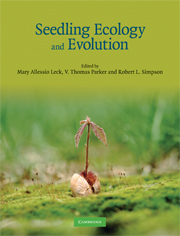Book contents
- Frontmatter
- Contents
- Contributors
- Foreword by Peter J. Grubb
- Preface
- Acknowledgments
- Part I Introduction
- Part II Seedling diversity
- Part III Seedling morphology, evolution, and physiology
- Part IV Life history implications
- Part V Applications
- Chapter 14 Does seedling ecology matter for biological invasions?
- Chapter 15 The role of seedlings in the dynamics of dryland ecosystems – their response to and involvement in dryland heterogeneity, degradation, and restoration
- Chapter 16 Anthropogenic disturbance in tropical forests: toward a functional understanding of seedling responses
- Chapter 17 Seedling establishment in restored ecosystems
- Part VI Synthesis
- References
- Index
Chapter 16 - Anthropogenic disturbance in tropical forests: toward a functional understanding of seedling responses
Published online by Cambridge University Press: 05 June 2012
- Frontmatter
- Contents
- Contributors
- Foreword by Peter J. Grubb
- Preface
- Acknowledgments
- Part I Introduction
- Part II Seedling diversity
- Part III Seedling morphology, evolution, and physiology
- Part IV Life history implications
- Part V Applications
- Chapter 14 Does seedling ecology matter for biological invasions?
- Chapter 15 The role of seedlings in the dynamics of dryland ecosystems – their response to and involvement in dryland heterogeneity, degradation, and restoration
- Chapter 16 Anthropogenic disturbance in tropical forests: toward a functional understanding of seedling responses
- Chapter 17 Seedling establishment in restored ecosystems
- Part VI Synthesis
- References
- Index
Summary
Introduction
The last decade has seen rapid growth in research dedicated to seedling ecology (Kitajima, 2007). This reflects an increased recognition of the importance of variation in seedling survival in determining patterns of adult abundance and distribution. Many seedling studies have grown out of larger programs investigating community dynamics in natural systems. Nonetheless, the results of these studies are often directly relevant to the management and conservation of human-altered ecosystems where changing environmental conditions and altered biotic interactions can directly affect seedling recruitment success. In extreme cases, human-mediated disturbances may be sufficient to invoke community-wide recruitment failure, leading to stalled succession or to shifts in vegetation type. Disturbance effects, however, can also have more subtle effects on recruitment success, resulting in changes in forest composition that may take decades or more to become apparent (Dirzo & Miranda, 1990).
Seedlings are particularly vulnerable to disturbance. Most species have no equivalent of the dormancy that facilitates seed survival through periods with adverse environmental conditions. Instead, alterations in light or soil moisture availability often impact seedlings first because their small leaf area and shallow rooting depth limit their ability to integrate resource capture over space. Similarly, only a small fraction of tree species have seed reserves that persist for more than a few months after germination, leaving seedlings vulnerable to damage and to temporal fluctuations in resource supply (Kitajima, 1996a; Harms & Dalling, 1997). Seedlings are also especially susceptible to natural enemies and fire.
- Type
- Chapter
- Information
- Seedling Ecology and Evolution , pp. 332 - 351Publisher: Cambridge University PressPrint publication year: 2008
- 3
- Cited by



